The VARK Model: Enhancing Learning Through Varied Sensory Input
VerifiedAdded on 2023/06/13
|8
|2139
|240
Essay
AI Summary
This essay provides a detailed overview of the VARK model, a learning style framework encompassing visual, auditory, reading/writing, and kinesthetic preferences. It explains each style, highlighting how learners effectively acquire knowledge through different sensory inputs and practical experiences. The essay also addresses criticisms of the VARK model, noting arguments against its universal applicability and effectiveness in enhancing learning outcomes. The report concludes by reinforcing the importance of understanding diverse learning styles and the potential benefits of implementing the VARK model in educational settings, while acknowledging the ongoing debate surrounding its validity.

VARK Model in learning
Paraphrase This Document
Need a fresh take? Get an instant paraphrase of this document with our AI Paraphraser

TABLE OF CONTENTS
INTRODUCTION......................................................................................................................3
Overview on VARK Model........................................................................................................3
Visual learning............................................................................................................................3
Auditory learning........................................................................................................................4
Reading and Writing...................................................................................................................4
Kinaesthetic.................................................................................................................................5
Criticisms of the VARK model...................................................................................................5
CONCLUSION...........................................................................................................................6
REFERENCES................................................................................................................................7
INTRODUCTION......................................................................................................................3
Overview on VARK Model........................................................................................................3
Visual learning............................................................................................................................3
Auditory learning........................................................................................................................4
Reading and Writing...................................................................................................................4
Kinaesthetic.................................................................................................................................5
Criticisms of the VARK model...................................................................................................5
CONCLUSION...........................................................................................................................6
REFERENCES................................................................................................................................7
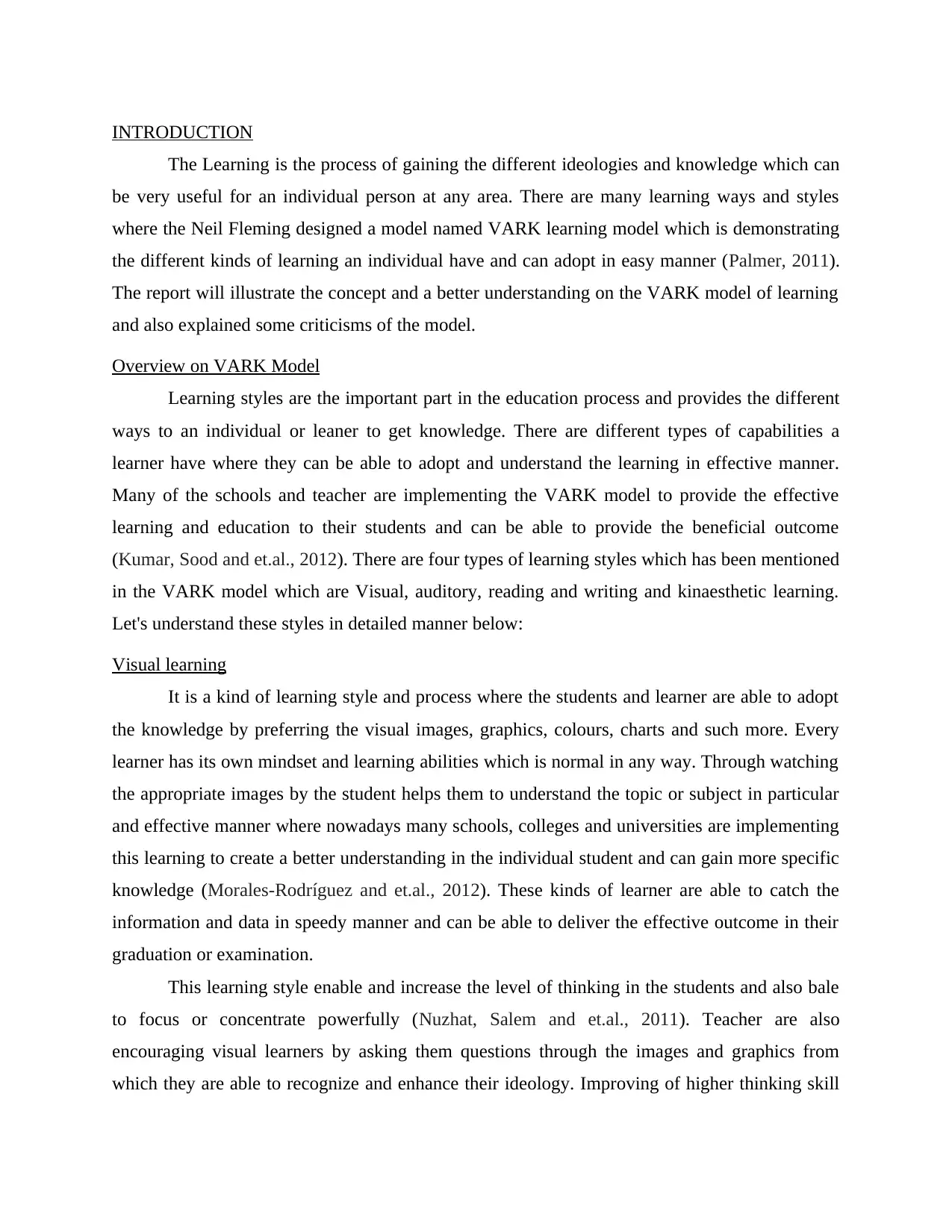
INTRODUCTION
The Learning is the process of gaining the different ideologies and knowledge which can
be very useful for an individual person at any area. There are many learning ways and styles
where the Neil Fleming designed a model named VARK learning model which is demonstrating
the different kinds of learning an individual have and can adopt in easy manner (Palmer, 2011).
The report will illustrate the concept and a better understanding on the VARK model of learning
and also explained some criticisms of the model.
Overview on VARK Model
Learning styles are the important part in the education process and provides the different
ways to an individual or leaner to get knowledge. There are different types of capabilities a
learner have where they can be able to adopt and understand the learning in effective manner.
Many of the schools and teacher are implementing the VARK model to provide the effective
learning and education to their students and can be able to provide the beneficial outcome
(Kumar, Sood and et.al., 2012). There are four types of learning styles which has been mentioned
in the VARK model which are Visual, auditory, reading and writing and kinaesthetic learning.
Let's understand these styles in detailed manner below:
Visual learning
It is a kind of learning style and process where the students and learner are able to adopt
the knowledge by preferring the visual images, graphics, colours, charts and such more. Every
learner has its own mindset and learning abilities which is normal in any way. Through watching
the appropriate images by the student helps them to understand the topic or subject in particular
and effective manner where nowadays many schools, colleges and universities are implementing
this learning to create a better understanding in the individual student and can gain more specific
knowledge (Morales-Rodríguez and et.al., 2012). These kinds of learner are able to catch the
information and data in speedy manner and can be able to deliver the effective outcome in their
graduation or examination.
This learning style enable and increase the level of thinking in the students and also bale
to focus or concentrate powerfully (Nuzhat, Salem and et.al., 2011). Teacher are also
encouraging visual learners by asking them questions through the images and graphics from
which they are able to recognize and enhance their ideology. Improving of higher thinking skill
The Learning is the process of gaining the different ideologies and knowledge which can
be very useful for an individual person at any area. There are many learning ways and styles
where the Neil Fleming designed a model named VARK learning model which is demonstrating
the different kinds of learning an individual have and can adopt in easy manner (Palmer, 2011).
The report will illustrate the concept and a better understanding on the VARK model of learning
and also explained some criticisms of the model.
Overview on VARK Model
Learning styles are the important part in the education process and provides the different
ways to an individual or leaner to get knowledge. There are different types of capabilities a
learner have where they can be able to adopt and understand the learning in effective manner.
Many of the schools and teacher are implementing the VARK model to provide the effective
learning and education to their students and can be able to provide the beneficial outcome
(Kumar, Sood and et.al., 2012). There are four types of learning styles which has been mentioned
in the VARK model which are Visual, auditory, reading and writing and kinaesthetic learning.
Let's understand these styles in detailed manner below:
Visual learning
It is a kind of learning style and process where the students and learner are able to adopt
the knowledge by preferring the visual images, graphics, colours, charts and such more. Every
learner has its own mindset and learning abilities which is normal in any way. Through watching
the appropriate images by the student helps them to understand the topic or subject in particular
and effective manner where nowadays many schools, colleges and universities are implementing
this learning to create a better understanding in the individual student and can gain more specific
knowledge (Morales-Rodríguez and et.al., 2012). These kinds of learner are able to catch the
information and data in speedy manner and can be able to deliver the effective outcome in their
graduation or examination.
This learning style enable and increase the level of thinking in the students and also bale
to focus or concentrate powerfully (Nuzhat, Salem and et.al., 2011). Teacher are also
encouraging visual learners by asking them questions through the images and graphics from
which they are able to recognize and enhance their ideology. Improving of higher thinking skill
⊘ This is a preview!⊘
Do you want full access?
Subscribe today to unlock all pages.

Trusted by 1+ million students worldwide
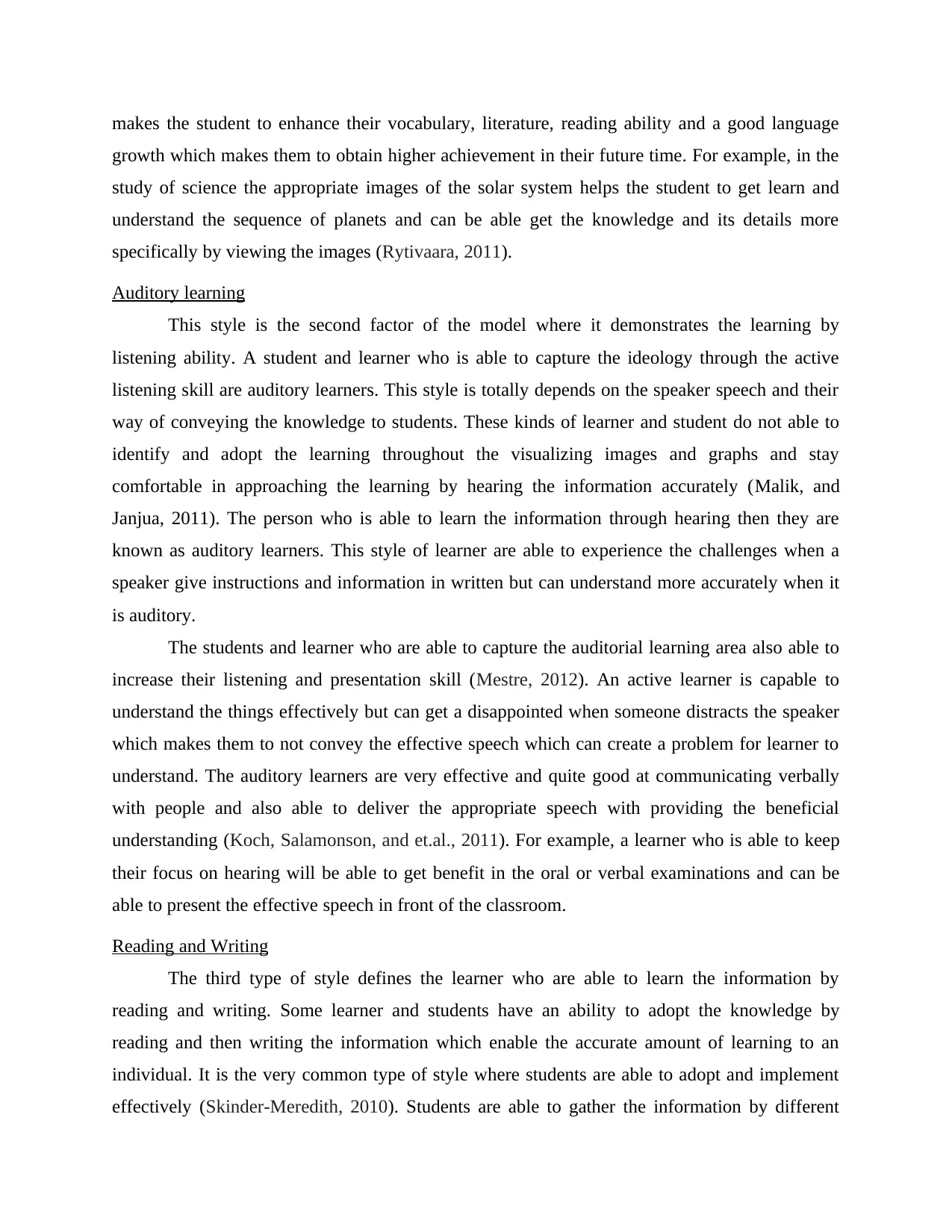
makes the student to enhance their vocabulary, literature, reading ability and a good language
growth which makes them to obtain higher achievement in their future time. For example, in the
study of science the appropriate images of the solar system helps the student to get learn and
understand the sequence of planets and can be able get the knowledge and its details more
specifically by viewing the images (Rytivaara, 2011).
Auditory learning
This style is the second factor of the model where it demonstrates the learning by
listening ability. A student and learner who is able to capture the ideology through the active
listening skill are auditory learners. This style is totally depends on the speaker speech and their
way of conveying the knowledge to students. These kinds of learner and student do not able to
identify and adopt the learning throughout the visualizing images and graphs and stay
comfortable in approaching the learning by hearing the information accurately (Malik, and
Janjua, 2011). The person who is able to learn the information through hearing then they are
known as auditory learners. This style of learner are able to experience the challenges when a
speaker give instructions and information in written but can understand more accurately when it
is auditory.
The students and learner who are able to capture the auditorial learning area also able to
increase their listening and presentation skill (Mestre, 2012). An active learner is capable to
understand the things effectively but can get a disappointed when someone distracts the speaker
which makes them to not convey the effective speech which can create a problem for learner to
understand. The auditory learners are very effective and quite good at communicating verbally
with people and also able to deliver the appropriate speech with providing the beneficial
understanding (Koch, Salamonson, and et.al., 2011). For example, a learner who is able to keep
their focus on hearing will be able to get benefit in the oral or verbal examinations and can be
able to present the effective speech in front of the classroom.
Reading and Writing
The third type of style defines the learner who are able to learn the information by
reading and writing. Some learner and students have an ability to adopt the knowledge by
reading and then writing the information which enable the accurate amount of learning to an
individual. It is the very common type of style where students are able to adopt and implement
effectively (Skinder‐Meredith, 2010). Students are able to gather the information by different
growth which makes them to obtain higher achievement in their future time. For example, in the
study of science the appropriate images of the solar system helps the student to get learn and
understand the sequence of planets and can be able get the knowledge and its details more
specifically by viewing the images (Rytivaara, 2011).
Auditory learning
This style is the second factor of the model where it demonstrates the learning by
listening ability. A student and learner who is able to capture the ideology through the active
listening skill are auditory learners. This style is totally depends on the speaker speech and their
way of conveying the knowledge to students. These kinds of learner and student do not able to
identify and adopt the learning throughout the visualizing images and graphs and stay
comfortable in approaching the learning by hearing the information accurately (Malik, and
Janjua, 2011). The person who is able to learn the information through hearing then they are
known as auditory learners. This style of learner are able to experience the challenges when a
speaker give instructions and information in written but can understand more accurately when it
is auditory.
The students and learner who are able to capture the auditorial learning area also able to
increase their listening and presentation skill (Mestre, 2012). An active learner is capable to
understand the things effectively but can get a disappointed when someone distracts the speaker
which makes them to not convey the effective speech which can create a problem for learner to
understand. The auditory learners are very effective and quite good at communicating verbally
with people and also able to deliver the appropriate speech with providing the beneficial
understanding (Koch, Salamonson, and et.al., 2011). For example, a learner who is able to keep
their focus on hearing will be able to get benefit in the oral or verbal examinations and can be
able to present the effective speech in front of the classroom.
Reading and Writing
The third type of style defines the learner who are able to learn the information by
reading and writing. Some learner and students have an ability to adopt the knowledge by
reading and then writing the information which enable the accurate amount of learning to an
individual. It is the very common type of style where students are able to adopt and implement
effectively (Skinder‐Meredith, 2010). Students are able to gather the information by different
Paraphrase This Document
Need a fresh take? Get an instant paraphrase of this document with our AI Paraphraser
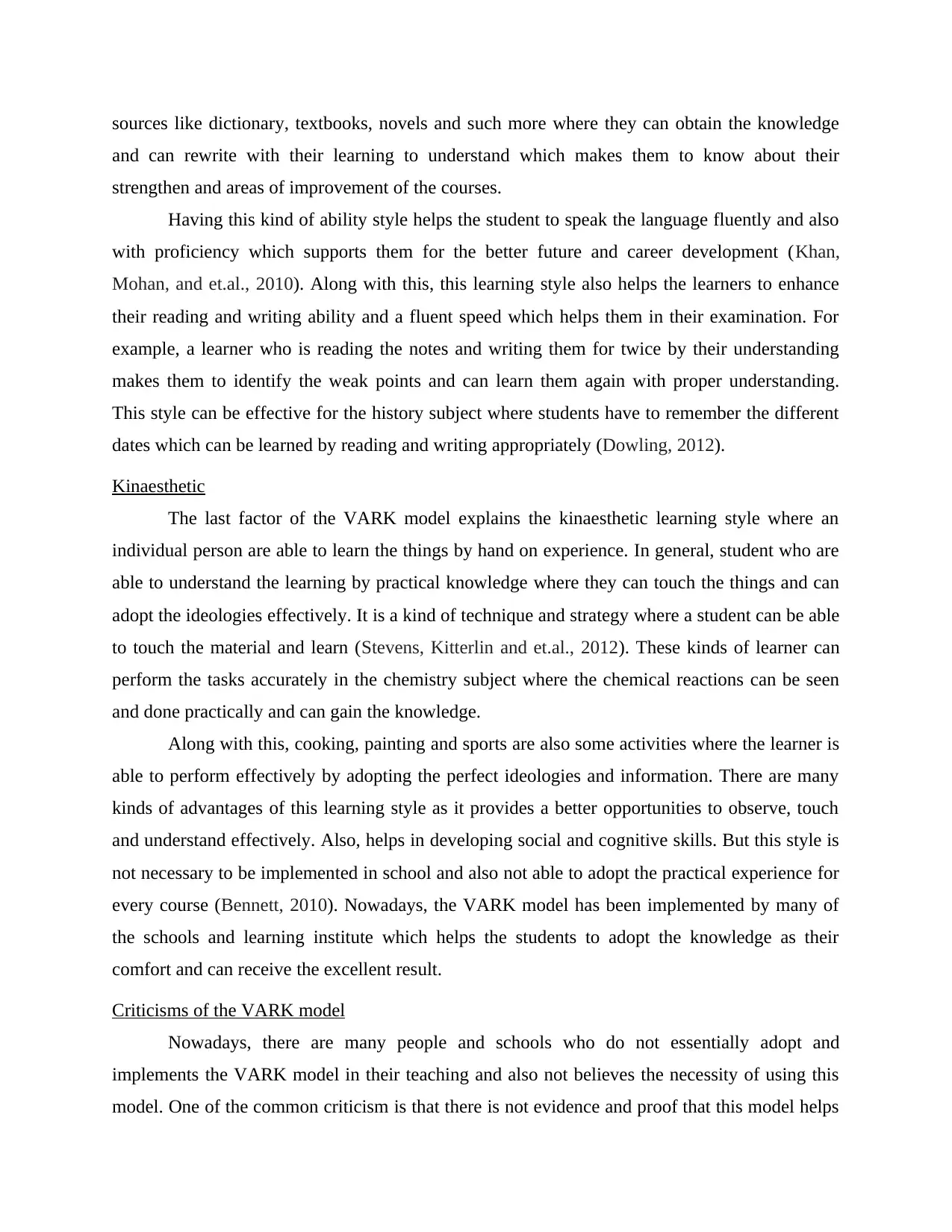
sources like dictionary, textbooks, novels and such more where they can obtain the knowledge
and can rewrite with their learning to understand which makes them to know about their
strengthen and areas of improvement of the courses.
Having this kind of ability style helps the student to speak the language fluently and also
with proficiency which supports them for the better future and career development (Khan,
Mohan, and et.al., 2010). Along with this, this learning style also helps the learners to enhance
their reading and writing ability and a fluent speed which helps them in their examination. For
example, a learner who is reading the notes and writing them for twice by their understanding
makes them to identify the weak points and can learn them again with proper understanding.
This style can be effective for the history subject where students have to remember the different
dates which can be learned by reading and writing appropriately (Dowling, 2012).
Kinaesthetic
The last factor of the VARK model explains the kinaesthetic learning style where an
individual person are able to learn the things by hand on experience. In general, student who are
able to understand the learning by practical knowledge where they can touch the things and can
adopt the ideologies effectively. It is a kind of technique and strategy where a student can be able
to touch the material and learn (Stevens, Kitterlin and et.al., 2012). These kinds of learner can
perform the tasks accurately in the chemistry subject where the chemical reactions can be seen
and done practically and can gain the knowledge.
Along with this, cooking, painting and sports are also some activities where the learner is
able to perform effectively by adopting the perfect ideologies and information. There are many
kinds of advantages of this learning style as it provides a better opportunities to observe, touch
and understand effectively. Also, helps in developing social and cognitive skills. But this style is
not necessary to be implemented in school and also not able to adopt the practical experience for
every course (Bennett, 2010). Nowadays, the VARK model has been implemented by many of
the schools and learning institute which helps the students to adopt the knowledge as their
comfort and can receive the excellent result.
Criticisms of the VARK model
Nowadays, there are many people and schools who do not essentially adopt and
implements the VARK model in their teaching and also not believes the necessity of using this
model. One of the common criticism is that there is not evidence and proof that this model helps
and can rewrite with their learning to understand which makes them to know about their
strengthen and areas of improvement of the courses.
Having this kind of ability style helps the student to speak the language fluently and also
with proficiency which supports them for the better future and career development (Khan,
Mohan, and et.al., 2010). Along with this, this learning style also helps the learners to enhance
their reading and writing ability and a fluent speed which helps them in their examination. For
example, a learner who is reading the notes and writing them for twice by their understanding
makes them to identify the weak points and can learn them again with proper understanding.
This style can be effective for the history subject where students have to remember the different
dates which can be learned by reading and writing appropriately (Dowling, 2012).
Kinaesthetic
The last factor of the VARK model explains the kinaesthetic learning style where an
individual person are able to learn the things by hand on experience. In general, student who are
able to understand the learning by practical knowledge where they can touch the things and can
adopt the ideologies effectively. It is a kind of technique and strategy where a student can be able
to touch the material and learn (Stevens, Kitterlin and et.al., 2012). These kinds of learner can
perform the tasks accurately in the chemistry subject where the chemical reactions can be seen
and done practically and can gain the knowledge.
Along with this, cooking, painting and sports are also some activities where the learner is
able to perform effectively by adopting the perfect ideologies and information. There are many
kinds of advantages of this learning style as it provides a better opportunities to observe, touch
and understand effectively. Also, helps in developing social and cognitive skills. But this style is
not necessary to be implemented in school and also not able to adopt the practical experience for
every course (Bennett, 2010). Nowadays, the VARK model has been implemented by many of
the schools and learning institute which helps the students to adopt the knowledge as their
comfort and can receive the excellent result.
Criticisms of the VARK model
Nowadays, there are many people and schools who do not essentially adopt and
implements the VARK model in their teaching and also not believes the necessity of using this
model. One of the common criticism is that there is not evidence and proof that this model helps
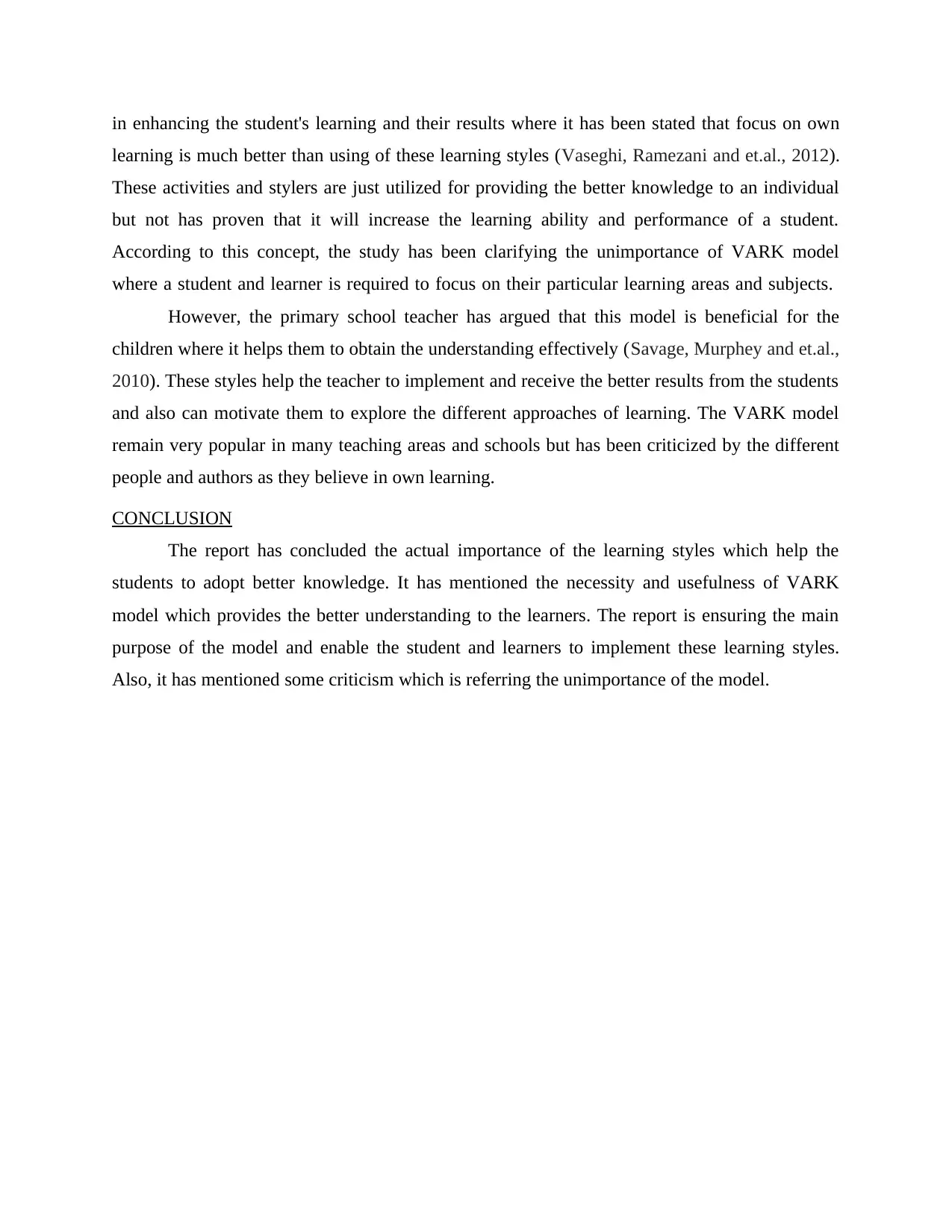
in enhancing the student's learning and their results where it has been stated that focus on own
learning is much better than using of these learning styles (Vaseghi, Ramezani and et.al., 2012).
These activities and stylers are just utilized for providing the better knowledge to an individual
but not has proven that it will increase the learning ability and performance of a student.
According to this concept, the study has been clarifying the unimportance of VARK model
where a student and learner is required to focus on their particular learning areas and subjects.
However, the primary school teacher has argued that this model is beneficial for the
children where it helps them to obtain the understanding effectively (Savage, Murphey and et.al.,
2010). These styles help the teacher to implement and receive the better results from the students
and also can motivate them to explore the different approaches of learning. The VARK model
remain very popular in many teaching areas and schools but has been criticized by the different
people and authors as they believe in own learning.
CONCLUSION
The report has concluded the actual importance of the learning styles which help the
students to adopt better knowledge. It has mentioned the necessity and usefulness of VARK
model which provides the better understanding to the learners. The report is ensuring the main
purpose of the model and enable the student and learners to implement these learning styles.
Also, it has mentioned some criticism which is referring the unimportance of the model.
learning is much better than using of these learning styles (Vaseghi, Ramezani and et.al., 2012).
These activities and stylers are just utilized for providing the better knowledge to an individual
but not has proven that it will increase the learning ability and performance of a student.
According to this concept, the study has been clarifying the unimportance of VARK model
where a student and learner is required to focus on their particular learning areas and subjects.
However, the primary school teacher has argued that this model is beneficial for the
children where it helps them to obtain the understanding effectively (Savage, Murphey and et.al.,
2010). These styles help the teacher to implement and receive the better results from the students
and also can motivate them to explore the different approaches of learning. The VARK model
remain very popular in many teaching areas and schools but has been criticized by the different
people and authors as they believe in own learning.
CONCLUSION
The report has concluded the actual importance of the learning styles which help the
students to adopt better knowledge. It has mentioned the necessity and usefulness of VARK
model which provides the better understanding to the learners. The report is ensuring the main
purpose of the model and enable the student and learners to implement these learning styles.
Also, it has mentioned some criticism which is referring the unimportance of the model.
⊘ This is a preview!⊘
Do you want full access?
Subscribe today to unlock all pages.

Trusted by 1+ million students worldwide
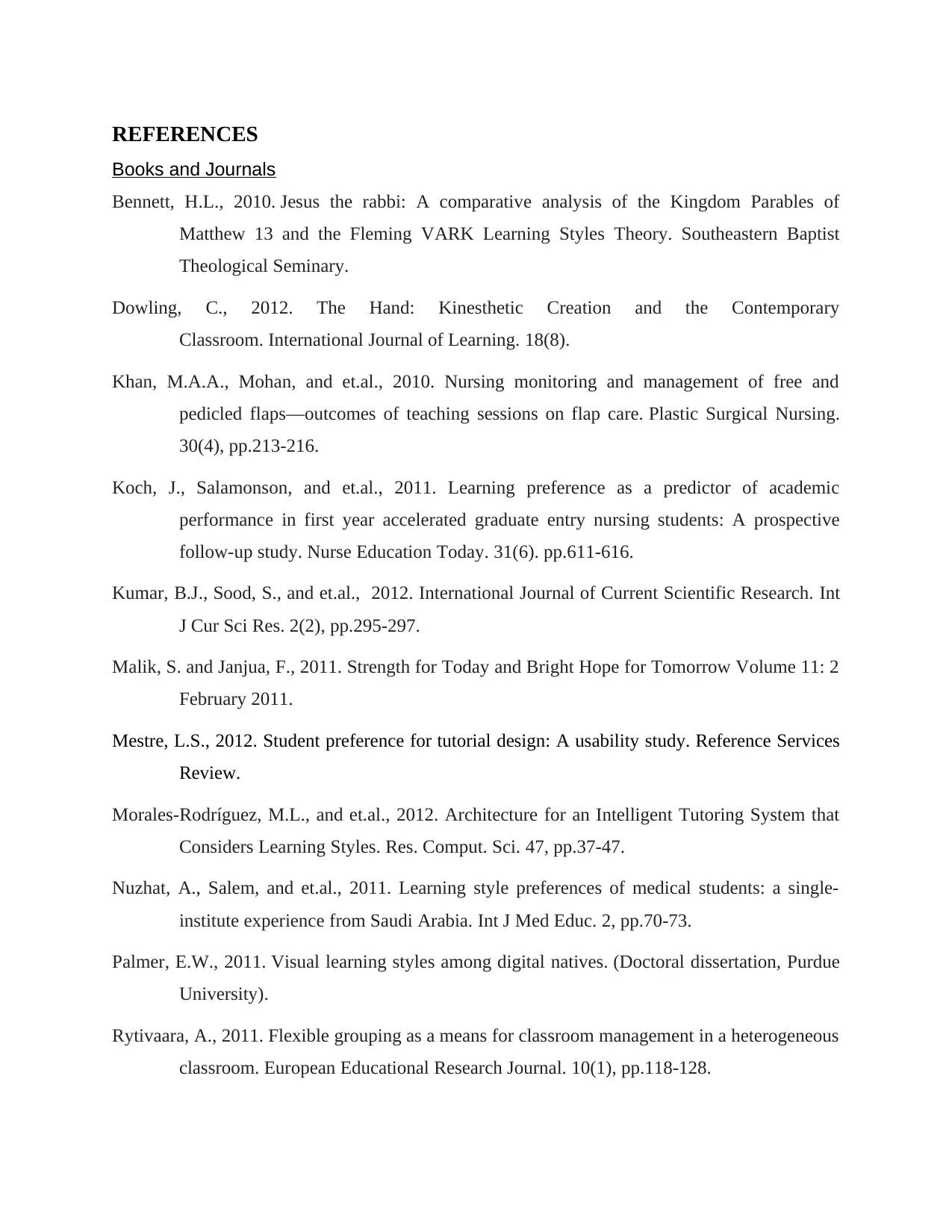
REFERENCES
Books and Journals
Bennett, H.L., 2010. Jesus the rabbi: A comparative analysis of the Kingdom Parables of
Matthew 13 and the Fleming VARK Learning Styles Theory. Southeastern Baptist
Theological Seminary.
Dowling, C., 2012. The Hand: Kinesthetic Creation and the Contemporary
Classroom. International Journal of Learning. 18(8).
Khan, M.A.A., Mohan, and et.al., 2010. Nursing monitoring and management of free and
pedicled flaps—outcomes of teaching sessions on flap care. Plastic Surgical Nursing.
30(4), pp.213-216.
Koch, J., Salamonson, and et.al., 2011. Learning preference as a predictor of academic
performance in first year accelerated graduate entry nursing students: A prospective
follow-up study. Nurse Education Today. 31(6). pp.611-616.
Kumar, B.J., Sood, S., and et.al., 2012. International Journal of Current Scientific Research. Int
J Cur Sci Res. 2(2), pp.295-297.
Malik, S. and Janjua, F., 2011. Strength for Today and Bright Hope for Tomorrow Volume 11: 2
February 2011.
Mestre, L.S., 2012. Student preference for tutorial design: A usability study. Reference Services
Review.
Morales-Rodríguez, M.L., and et.al., 2012. Architecture for an Intelligent Tutoring System that
Considers Learning Styles. Res. Comput. Sci. 47, pp.37-47.
Nuzhat, A., Salem, and et.al., 2011. Learning style preferences of medical students: a single-
institute experience from Saudi Arabia. Int J Med Educ. 2, pp.70-73.
Palmer, E.W., 2011. Visual learning styles among digital natives. (Doctoral dissertation, Purdue
University).
Rytivaara, A., 2011. Flexible grouping as a means for classroom management in a heterogeneous
classroom. European Educational Research Journal. 10(1), pp.118-128.
Books and Journals
Bennett, H.L., 2010. Jesus the rabbi: A comparative analysis of the Kingdom Parables of
Matthew 13 and the Fleming VARK Learning Styles Theory. Southeastern Baptist
Theological Seminary.
Dowling, C., 2012. The Hand: Kinesthetic Creation and the Contemporary
Classroom. International Journal of Learning. 18(8).
Khan, M.A.A., Mohan, and et.al., 2010. Nursing monitoring and management of free and
pedicled flaps—outcomes of teaching sessions on flap care. Plastic Surgical Nursing.
30(4), pp.213-216.
Koch, J., Salamonson, and et.al., 2011. Learning preference as a predictor of academic
performance in first year accelerated graduate entry nursing students: A prospective
follow-up study. Nurse Education Today. 31(6). pp.611-616.
Kumar, B.J., Sood, S., and et.al., 2012. International Journal of Current Scientific Research. Int
J Cur Sci Res. 2(2), pp.295-297.
Malik, S. and Janjua, F., 2011. Strength for Today and Bright Hope for Tomorrow Volume 11: 2
February 2011.
Mestre, L.S., 2012. Student preference for tutorial design: A usability study. Reference Services
Review.
Morales-Rodríguez, M.L., and et.al., 2012. Architecture for an Intelligent Tutoring System that
Considers Learning Styles. Res. Comput. Sci. 47, pp.37-47.
Nuzhat, A., Salem, and et.al., 2011. Learning style preferences of medical students: a single-
institute experience from Saudi Arabia. Int J Med Educ. 2, pp.70-73.
Palmer, E.W., 2011. Visual learning styles among digital natives. (Doctoral dissertation, Purdue
University).
Rytivaara, A., 2011. Flexible grouping as a means for classroom management in a heterogeneous
classroom. European Educational Research Journal. 10(1), pp.118-128.
Paraphrase This Document
Need a fresh take? Get an instant paraphrase of this document with our AI Paraphraser

Savage, L., Murphey, J. and et.al., 2010. Developing and maintaining competency with
circulatory assist devices: how to meet the challenge. Progress in Transplantation.
20(2), pp.125-128.
Skinder‐Meredith, A.E., 2010. Innovative activities for teaching anatomy of speech
production. Anatomical Sciences Education. 3(5). pp.234-243.
Stevens, D.P., Kitterlin, M. and et.al., 2012. Assessing the Impact of Learning Styles for
Hospitality Students. Consortium Journal of Hospitality & Tourism. 17(1).
Vaseghi, R., Ramezani, A.E. and et.al., 2012. Language learning style preferences: A theoretical
and empirical study. Advances in Asian Social Science. 2(2), pp.441-451.
circulatory assist devices: how to meet the challenge. Progress in Transplantation.
20(2), pp.125-128.
Skinder‐Meredith, A.E., 2010. Innovative activities for teaching anatomy of speech
production. Anatomical Sciences Education. 3(5). pp.234-243.
Stevens, D.P., Kitterlin, M. and et.al., 2012. Assessing the Impact of Learning Styles for
Hospitality Students. Consortium Journal of Hospitality & Tourism. 17(1).
Vaseghi, R., Ramezani, A.E. and et.al., 2012. Language learning style preferences: A theoretical
and empirical study. Advances in Asian Social Science. 2(2), pp.441-451.
1 out of 8
Related Documents
Your All-in-One AI-Powered Toolkit for Academic Success.
+13062052269
info@desklib.com
Available 24*7 on WhatsApp / Email
![[object Object]](/_next/static/media/star-bottom.7253800d.svg)
Unlock your academic potential
Copyright © 2020–2025 A2Z Services. All Rights Reserved. Developed and managed by ZUCOL.




